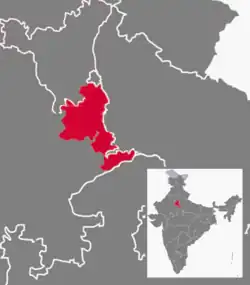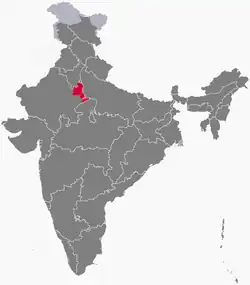Mewat
میوات | |
|---|---|
Historical Region | |
 | |
 | |
| Country | |
| Historical Capital | Alwar |
| Demonym | Mewati |
| Mewat Region | |
| • Haryana tehsils | Nuh, Punahana, Firozpur Jhirka, Hathin |
| • Rajasthan: Alwar Tehsils | Ramgarh, Laxmangarh, Kathumar, Umren, Kherli |
| • Rajasthan: Bharatpur Tehsils | Pahari, Nagar, Kaman. Deeg, Nadbai, Bhusawar, Weir |
| • Uttar Pradesh Tehsils | Chhata Tehsil in Mathura district |
| Languages | |
| • Official | English, Hindi, Urdu |
| • Spoken | Mewati Urdu |
Mewat is a historical and cultural region which encompasses parts of the modern-day states of Haryana, Rajasthan, and Uttar Pradesh in northwestern India.
Geography
The loose boundaries of the Mewat region generally include parts of the following districts:
- Nuh district (Nuh, Punahana, Ferozepur Jhirka, Taoru) of Haryana
- Palwal district (Hathin, Hodal) of Haryana
- Faridabad district (Ballabhgarh) of Haryana
- Alwar district (Tijara, Kishangarh Bas, Ramgarh, Laxmangarh, Kathumar, Aravalli hills tract) of Rajasthan
- Dausa district (Mahwa, Mandawar) of Rajasthan
- Bharatpur district (Pahari, Nagar, Deeg, Nadbai, Bhusawar, Weir, Kaman) of Rajasthan.
- Mathura district (Chhata)
The region is located at the intersection of three states: Rajasthan, Haryana, and Uttar Pradesh. In between the major cities of Delhi, Jaipur and Agra. The historical capital of the region is Alwar in modern day Rajasthan.[1][2]
The region roughly corresponds to the ancient kingdom of Matsya, founded in the 5th century BCE.
History
Wali-e-Mewati
The title of Wali-e-Mewat was used by the Khanzada Mewati rulers of Mewat State from 1372 till 1527, who ruled Mewat as an independent state. In 1372, Sultan Firuz Shah Tughlaq granted Raja Nahar Khan Mewati of Kotla Fort, the Lordship of Mewat. He established a hereditary polity in Mewat and proclaimed the title of Wali-e-Mewat. Later his descendants affirmed their own sovereignty in Mewat and ruled there till 1527.
British Era
During the British raj, they became under the Alwar state and Bharatpur state. After the Indian Rebellion of 1857 the area passed to the direct control of British rule.
Furthermore, during the colonial era, religious syncretism was seen throughout the region.
"The Meos (Muhammadans) of the eastern Punjab still participate in the observance of the Holi and Diwali festivals. On the latter occasion they paint the horns, hoofs, etc., of their bullocks and join in the general rejoicings".[3]: 174
— Excerpt from the Census of India (Punjab Province), 1911 AD
Post Indian Independence Era
During 1947, thousands of Meo were displaced from Alwar district and Bharatpur district. Many Thousands were killed. They shifted to Gurgaon and many went to Pakistan. Bacchu Singh, the prince of Bharatpur, played a main role in this act of ethnic cleansing. Earlier Kathumar, Nadbai, Kumher, Kherli, Bhusawar, Weir and till Mahwa was heavily populated with the Meo population.The population of Meos drastically decreased in Alwar and Bharatpur however many old mosques are still present there.
Mahatama Gandhi also visited the village of Ghasera in the Nuh district and requested Meos not to leave India. Because of Mahatama Gandhi some Meos were resettled in Laxmangarh, Nagar, Kaman, Deeg of Alwar district and Bharatpur district. Due to this, the people of Ghasera still celebrate Mewat Day.
Chaudhary Rahim Khan from the village of Sultanpur in Punahana is said to be the individual who united the ethnic Meos that were scattered across India.[4]
Culture
The Hindu inhabitants of in the region of Mewat, although belonging to the same Kshatriya castes to which the Meos belonged before conversion to Islam, are not called Meo, which is the ethnic group originating from the region. Thus the word Meo is both region-specific and religion-specific.[5] The Meo community in Mewat adheres to the Islam, yet their ethnic framework finds its origins in the hierarchical structure of Hindu caste society. Cultural aspects are largely shared between the Meos and their Hindu counterparts in neighboring regions of Haryana and Rajasthan. Additionally, the neighboring Hindu Jats, Meenas Ahirs and Rajputs also share the same cultural customs.
Language
Mewati, an Indo-Aryan language is spoken in rural areas of the region. With approximately three million speakers, Mewati serves as a significant linguistic identifier within the Meo culture. While other ethnic groups in the area also use the Mewati language, it remains a distinctive feature integral to Meo heritage and identity. Ahirwati, a dialect of Mewati, is spoken in the Ahirwal region as well.
Economic and infrastructure developments
The main occupation in district is agriculture along with allied and agro-based activities. The Meo Rajputs are the predominant population group and are all agriculturists.[6] Agriculture is mostly rain fed except in small pockets where canal irrigation is available. Agriculture production measured in terms of crop yield per hectare is low in comparison to the other districts of the State. Animal husbandry, particularly dairy, is the secondary source of income for the people and those who live closer to the hilly ranges of Aravali also keep sheep and goats. Milk yields are not so low, however, due to heavy indebtedness most of the farmers are forced to sell the milk to the lenders at lower than normal price, which drastically reduces their income from the milk. Towns like Punhana, Pinangwan, Ferozepur Jhirka, Taoru and Nuh are major hub of retail shops and acts as backbone of day-to-day life in area. The district also has a MMTC-PAMP factory located in the Rojka-Meo industrial estate.
The Delhi Mumbai Expressway is an under construction expressway which will pass through Mewat. Gurugram-Sohna-Nuh-Alwar road has been upgraded to National Highway and is known as NH 248A. Western Peripheral Expressway passing through Mewat also provides high speed connectivity to NH-8. The planned Rewari-Bhiwadi-Palwal railway line and Delhi-Sohna-Nuh-Ferozepur Jhirka-Alwar railway will pass through Mewat near district headquarter, Nuh.
Shaheed Hasan Khan Mewati Government Medical College at Nalhar is now operational near Nuh. Haryana Wakf Board has set up its first engineering college in Mewat which is operational near Nuh.
Mewat is one of the most underdeveloped area of the nation, Up to 60% of men here find employment as truck drivers and only few schools go beyond 8th class schooling.[7]
Demographics
The population of Mewat District.
| Title | Details |
|---|---|
| Population | 10,89,406 |
| Population(Male) | 5,71,480 (52.45%) |
| Population(Female) | 5,17,926 (47.54%) |
| Source:[8] | |
Media
Mewat has two community radio stations: Radio Mewat and Alfaz-e-Mewat. Radio Mewat, launched in 2010, endeavors to give voice to the voiceless in backward communities. Alfaz-e-Mewat, launched in 2012, provides rural communities in and around the Mewat district with information and participatory dialogue about agriculture, water and soil health, and governance issues.
Mewat has its own monthly magazine named Mewat Kal AAj Kal. This magazine runs by Mewati students who studied in different esteemed and prestigious educational institutions across the country. Presently Mohd Juber Khan is the editor & publisher of this RNI registered magazine. Mr. Khan did Journalism (Honours) from University Of Delhi and accomplished Master's in Mass Communication from Anwar Jamal Kidwai Mass Communication Research Centre, Jamia Millia Islamia New Delhi. He is acquired TV Journalist and professional media practitioner in mainstream Indian Media.
Mewati Gharana is a distinctive style of Indian classical music.
See also
References
- ↑ Mewat The Imperial Gazetteer of India, 1909, v. 17, p. 313.
- ↑ Meet the muslims who consider themselves descendants of arjuna, Scroll.in, 30 March 2016.
- ↑ "Census of India, 1911 Volume XIV Punjab" (PDF). Retrieved 21 July 2022.
- ↑ "Shri Rahim Khan MP biodata Faridabad | ENTRANCE INDIA". 26 December 2018. Retrieved 6 December 2023.
- ↑ Prasad, Jitendra (2003). "Plural ethnic group characteristics: The nature of identity formation in Haryana". Guru Nanak Journal of Sociology. 24 (2): 1–21. ISSN 0970-0242. Retrieved 13 May 2011.
- ↑ توصیف الحسن میواتی الہندی (23 August 2020). تاریخِ میو اور داستانِ میوات.
- ↑ Haryana elections: Turncoats and dynasts lead BJP battle for first victory in Mewat, Times of India, 18 October 2019.
- ↑ "Demography | District Administration, Nuh | India". Retrieved 28 April 2021.
- "MEWAT DISTRICT FULL DETAIL". mewat.govt.in (in Hindi). Retrieved 3 September 2019.
External links
- Mewat Development Agency
- http://www.rkktrust.org/
- Against History, Against State: Counterperspectives from the Margins by Shail Mayaram
- http://www.radiomewat.org/
- Sehgal Foundation
Mewat people's also called as "Mewati"